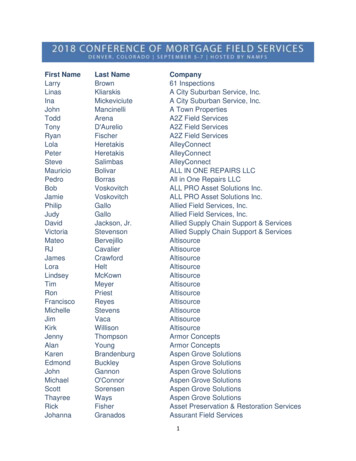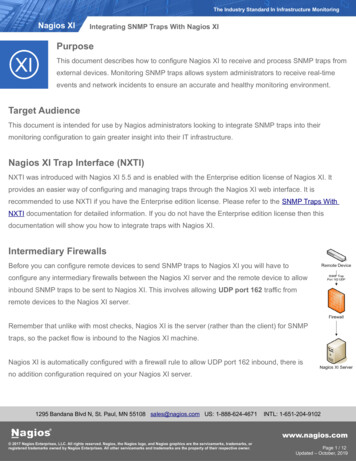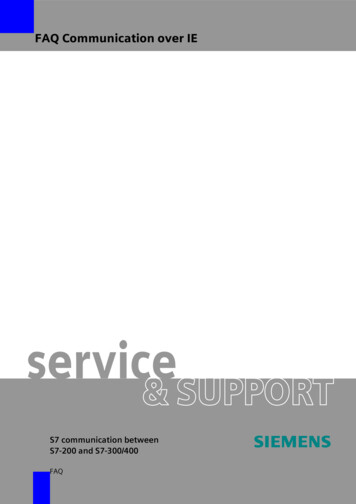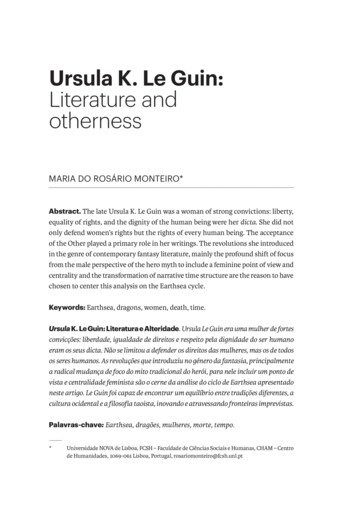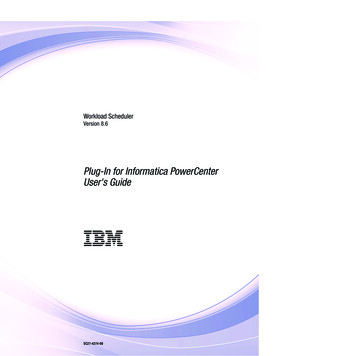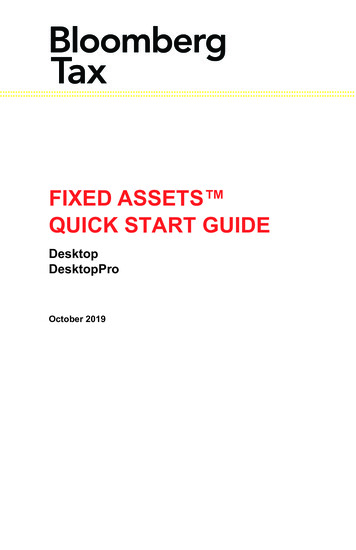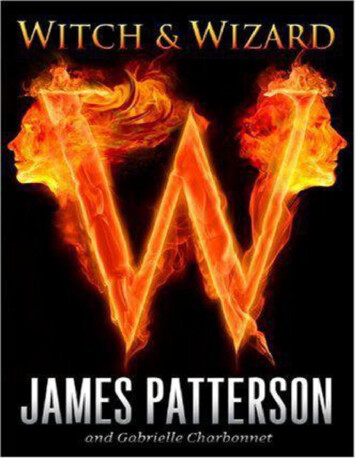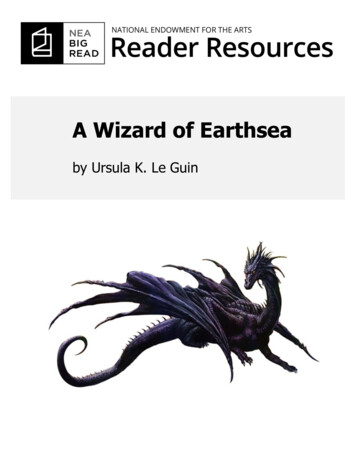
Transcription
A Wizard of Earthseaby Ursula K. Le Guin1
Table of ContentsA Wizard ofEarthseaAbout the Book. 3About the Author . 5Historical and Literary Context . 7Other Works/Adaptations . 9Discussion Questions. 10Additional Resources . 11Credits . 12“To me a novel canbe as beautiful asany symphony, asbeautiful as thesea.”PrefaceUrsula K. Le Guin's A Wizard of Earthsea has become a classiccoming-of-age novel. Originally published as a young-adultfantasy novel in 1968, Le Guin's adventure tale proved soimaginatively engaging and psychologically profound that itcaptivates readers of all ages.What is the NEA Big Read?A program of the National Endowment for the Arts, the NEABig Read broadens our understanding of our world, ourcommunities, and ourselves through the joy of sharing a goodbook. Managed by Arts Midwest, this initiative offers grants tosupport innovative community reading programs designedaround a single book.A great book combines enrichment with enchantment. Itawakens our imagination and enlarges our humanity. It canoffer harrowing insights that somehow console and comfortus. Whether you’re a regular reader already or making up forlost time, thank you for joining The Big Read.NEA Big ReadThe National Endowment for the Arts2
About the BookIntroduction to theBookUrsula K. Le Guin's A Wizard ofEarthsea (1968) is arguably themost widely admired Americanfantasy novel of the past fiftyyears. The book's elegantdiction, geographical sweep,and mounting suspense arequite irresistible. Earthsea—composed of an archipelago ofmany islands—is a land of theimagination, like Oz, Faerie, orthe dream-like realm of ourunconscious. Earthsea may notbe a "real" world but it is one that our souls recognize asmeaningful and "true." Actions there possess an epicgrandeur, a mythic resonance that we associate withromance and fairy tale.Songs, poems, runes, spells—words matter a great deal inEarthsea, especially those in the "Old Speech" now spokenonly by dragons and wizards. To work a spell one must knowan object or person's "true name," which is nothing less thanthat object or person's fundamental essence. In Earthsea, toknow a person's true name is to gain power over him or her."A mage," we are told, "can control only what is near him,what he can name exactly and wholly."Understanding the nature of things, not possessing powerover them, is the ultimate goal of magic. Indeed, the greatestwizards do all they can to avoid using their skill. Theyrecognize that the cosmos relies on equilibrium,appropriateness, and "balance"—the very name Earthseasuggests such balance—and that every action bearsconsequences. To perform magic, then, is to take on a heavyresponsibility: One literally disturbs the balance of theuniverse.The young Ged is born—a fated seventh son—on the island ofGont and, by accident, discovers that he possesses an innatetalent for magic. Even as an untrained boy he is able to usehis nascent powers to save his town from marauders. Soon,though, he goes to study with gentle Ogion the Silent, whomhe foolishly fails to appreciate. Sent to complete his studies atthe Archmage's school for wizards on the island of Roke, Gedgrows increasingly proud, over-confident, and competitive. Todisplay his much-vaunted skills, he rashly attempts adangerous spell—with dire consequences for Earthsea andhimself. Hoping to repair the damage he has caused, thechastened Ged embarks on a series of journeys aroundEarthsea—and eventually beyond the known world.NEA Big ReadThe National Endowment for the ArtsMajor Characters in the BookGedThe hero of A Wizard of Earthsea is called Duny by his familyand known to the world as Sparrowhawk. But Ged is hishidden true name, disclosed to him in an adolescent rite ofpassage. He must learn self-discipline, humility, and thepower of silence. By so doing, he gradually acquires the innerbalance and wisdom that will make him, in due course,worthy of two other names: Archmage and dragonlord.Ogion the SilentThis quiet, philosophical magician is Ged's first teacher. Helives on the island of Gont in utter simplicity, yet his powersare formidable. Ogion urges moderation and restraint to theimpetuous Ged—to no avail. His manner recalls that of aTaoist master, practicing stillness and non–interference (wu–wei).Jasper and VetchAt Roke, where Ged has gone to learn magic, he makes anenemy of the quicksilver Jasper and a friend of the stolidVetch. These two boys pull Ged in different directions: Jaspertaunts him to demonstrate just how good a magician hereally is; Vetch, hoping to temper the rivalry, repeatedlyurges restraint and caution. Jasper eventually leads Ged intooverestimating his powers, with terrible consequences.Serret and YarrowThese are the two principal female figures in the novel, onereminding Ged of the dark allure of great power, the other ofthe satisfactions of an ordinary life. Serret is the seductivechatelaine of a strange castle, who nurses a ravaged Gedback to health—but for purposes of her own. By contrast,Vetch's sister, the kind-hearted Yarrow, offers the evengreater temptation of a family, home, and children.The ShadowWhen Ged works a summoning spell over which he doesn'thave full control, he releases a dark formless power of"unlife" into the world. It apparently seeks to take over hisbody and wreak evil through him. Much of the second half ofA Wizard of Earthsea focuses on the contest between theyoung magician and this creature of darkness. But what,really, is the Shadow?3
Sources of InspirationThe Language of FantasyA writer, like a wizard, creates with words. Throughout AWizard of Earthsea Le Guin's language is plain, strong, andexact; her tone grave and slightly formal; and the rhythm ofher sentences carefully balanced and musical. Note theoccasional touches of alliteration and assonance—reminiscentof Old English verse—in such phrases as this: "Forest risesridge behind ridge to the stone and snow of the heights."TaoismThis ancient Chinese philosophy pervades Le Guin's work. LaoTzu's poetic meditation on how to live, the Tao-Te-Ching—roughly "The Classic Book of Integrity and the Way"—emphasizes silence, peace, and non-violence. It rejectsdualism—good vs. evil, light vs. dark—for mutualinterdependence, typically represented by the yin–yangsymbol, made up of interlocking light and dark semi-circles.The Journey into the SelfLe Guin's work draws on several ideas and symbols used incultural anthropology (see, especially, Arnold van Gennep's1909 classic, The Rites of Passage). Some of these elementsinclude rites of initiation, night–sea voyages, rituals of deathand rebirth, and what the psychologist Carl Gustav Jungcalled archetypal images: the wise old man, the helpfulanimal, the Shadow.DragonsDragons are ambiguous creatures in Earthsea. They arefearsome and destructive yet they possess great wisdom.While most literary dragons are creatures of darkness—William Blake's horrific red dragon, the covetous Smaug ofTolkien's The Hobbit, the devil serpent defeated by St.George—Le Guin's dragons are great forces of nature,dangerous and sublime.NEA Big ReadThe National Endowment for the Arts4
About the AuthorUrsula K. Le Guin(b. 1929)Ursula K. Le Guin spent herchildhood in California, mainlyin Berkeley, where heranthropologist father (AlfredL. Kroeber) was a professor,but also in the Napa Valley,where her family owned aranch. As a child she heardNative American myths asbedtime stories, while alsohaving the run of her parents' Ursula K. Le Guin (CopyrightMarian Wood Kolisch)library. The young Le Guinread voraciously. Her favoritebooks included the Norse myths, retellings of folktales andlegends from J.G. Frazer's The Golden Bough (1890), and thefantasy stories of Lord Dunsany. Such a background mayexplain, in part, Le Guin's own approach to literature: She is aworld–builder. Indeed, just as an anthropologist reports on anindigenous people in as much detail as possible, so a sciencefiction or fantasy author will build up an elaborate picture ofan alien culture and its inhabitants.In her teens, Le Guin read fantasy and science fictionmagazines but also devoured many of the classics of worldliterature. She once listed her influences as Percy ByssheShelley; John Keats; William Wordsworth; Giacomo Leopardi;Victor Hugo; Rainer Maria Rilke; Edward Thomas; TheodoreRoethke; Charles Dickens; Leo Tolstoy; Ivan Turgenev; AntonChekhov; Boris Pasternak; Charlotte, Emily, and Anne Brontë;Virginia Woolf; and E. M. Forster. Among science fictionauthors, she has spoken with admiration about the fiction ofCordwainer Smith (Paul M.A. Linebarger); James Tiptree, Jr.(Alice B. Sheldon); and Philip K. Dick. A lifelong interest inLao Tzu and Taoism eventually led her to translate the TaoTe-Ching (1999).Le Guin attended Radcliffe College and then ColumbiaUniversity, where she earned a master's degree in Italian andFrench, with a focus on Renaissance literature. While on atrip to France, she met her future husband, the historianCharles A. Le Guin. The couple settled in Portland, Oregon,with their three children. Le Guin has said that she enjoys avery regular life there and prefers things to be "kind of dull,basically," so that she can get on with her work as a writer.While preferring a quiet routine and privacy, Ursula K. LeGuin does speak out strongly on matters she cares about—American politics, the value of fantasy and science fiction, theimportance of reading, and, above all, the condition ofwomen in the arts and society. During much of the 1970s andNEA Big ReadThe National Endowment for the Arts'80s, she was a frequent speaker and instructor at writingworkshops around the country.Over the years Le Guin has won numerous awards for hernovels and stories, including the Hugo and Nebula for sciencefiction, but also the Boston Globe–Horn Book Award (for AWizard of Earthsea) the National Book Award, and theNational Book Foundation Medal for DistinguishedContribution to American Letters. She is perhaps the mosthonored living writer of science fiction and fantasy—and oneof America's finest writers.An Interview with Ursula K. Le GuinOn January 7, 2008, Dan Stone of the National Endowmentfor the Arts interviewed Ursula K. Le Guin at her home inOregon. Excerpts from their conversation follow.Dan Stone: What does fantasy allow you to do that realisticfiction doesn't?Ursula K. Le Guin: Fantasy has a much larger world to playwith than realism does. Realism is stuck pretty much with thehere and now because as soon as you get more than acentury in the past, you're writing historical fiction, which is aform of fantasy. Fantasy has all the past and all the future toplay with, if it wants to call it the future. It opens all thedoors and windows of the house of fiction and says, "Look,you can go out any door here and come in a different one."DS: You've talked before about wizardry being akin toartistry. Do you see A Wizard of Earthsea being about artistryitself?UKL: What a wizard does is like what a writer does. He orshe is making things out of words and making things happenwith words. I saw the parallel. But I don't know where it goesor really what to do with it. I've always been talking aboutlanguage, about speech, about words, about books, as agreat power in our lives. This is obviously one of my themes.DS: How were wizards depicted in literature before A Wizardof Earthsea?UKL: I believe I'm the first who described a wizard having tolearn his trade and go to school to do it. I started thinkingthat wizards can't have always been old guys with whitebeards. So what were they like when they were fourteen?And that opens up a world, doesn't it?DS: Is it true that when you wrote the novel, you had not yetread Carl Jung?UKL: Yes. That was an amazing coincidence, if you want tosee it as such, how two incredibly different minds arrived at5
the same point by incredibly different routes. Jung came tohis idea of the Shadow through psychology; I came to itthrough pure fictional imagination. Ged has a darkness in himthat he couldn't handle. Ged and I learned how to face hisenemy as I wrote the book. I was not certain what the endwould be until I got to it.DS: Some of those same ideas are found in Taoistphilosophies, the ideas of balance, equilibrium, light and dark.UKL: Yes, you could say that A Wizard of Earthsea is full ofTaoist imagery. The whole idea of a vital balance which isnever still, which is not at rest. The wise wizards are workingfor a kind of balance. Young Ged gets out of balance. He'sgot to fix it or else it'll kill him.DS: For what age group did you write this book?UKL: In 1968, young-adult fiction was a category, but itwasn't particularly noticed. The first-edition cover flap says"eleven and up," which I think is about right. Fantasy crossesgeneration lines like no other literature. People who likefantasy tend to begin liking it as kids, and then twenty yearslater, they will go back to these books and find a whole newjoy in them. Fantasy has an incredible availability to agrandfather and granddaughter at the same time. As a writer,it's wonderful, because if you write it with all your heart andall your art, you'll have readers that will be coming back to itthe rest of their lives.NEA Big ReadThe National Endowment for the Arts6
Historical and Literary ContextFantasy, Science Fiction, andUrsula K. Le Guin The Twilight Zone, The Outer Limits, and Star Trekbecome hit television shows. 1963: Maurice Sendak revolutionizes children's picturebooks with Where the Wild Things Are.1920s 1922: E. R. Eddison brings out his epic fantasy TheWorm Ouroboros. 1926: Book-of-the-Month Club is founded. 1929: Ursula Kroeber is born in Berkeley, California, onOctober 21.1930s Ursula Kroeber grows up surrounded by books andthree older brothers, and passes her summers on aranch in the Napa Valley. 1938: T. H. White publishes his beloved Arthurianfantasy, The Sword in the Stone. 1939: The first Worldcon—science fiction's annualconvention—takes place. Ursula K. Le Guin begins to publish science fiction andfantasy. A Wizard of Earthsea receives the BostonGlobe-Horn Book Award in 1968.1970s Le Guin grows increasingly active as a teacher, mentor,and example to younger writers of fantasy and sciencefiction, particularly women. 1979: Angela Carter's The Bloody Chamber re-imaginesclassic fairy tales from a feminist perspective. Fantasy becomes a dominant aspect of muchinnovative fiction around the world, notably in the workof Italo Calvino, Jorge Luis Borges, John Barth, DonaldBarthelme, and many others.1980s1940s This is the great decade of the science fiction andfantasy magazines, including Amazing Stories,Astounding Science Fiction, Startling Stories, andThrilling Wonder Stories. 1947: Ursula Kroeber enters Radcliffe College. Mervyn Peake creates his expressionist Gothicmasterpiece, Titus Groan in 1946, followed byGormenghast in 1950 and Titus Alone in 1959.1950s This is the heyday of flying saucers, alien invaders, thespace race, comic-book heroes, and fears of atomicdisaster. 1953: Ursula Kroeber continues her studies in romancelanguages at Columbia; marries historian Charles LeGuin. 1954–1955: J. R. R. Tolkien's The Lord of the Rings ispublished.NEA Big Read1960sThe National Endowment for the Arts 1981: John Crowley creates a genuinely Americanfantasy classic, Little, Big. 1985: Le Guin creates the dossier-like Always ComingHome, the portrait of a peaceful, cooperative culture.She also brings out a series of fairy tales and picturebooks for young children. More and more women publish science fiction andfantasy, including Joanna Russ, C.J. Cherryh, OctaviaE. Butler, Tanith Lee, Karen Joy Fowler, and ConnieWillis.1990s Author websites, fan groups, and online discussions offantasy and science fiction proliferate on the Internet. 1990: Le Guin returns to Earthsea with Tehanu. 1996: Philip Pullman publishes The Golden Compass,followed by The Subtle Knife in 1997, and The AmberSpyglass in 2000.7
2000s Le Guin continues to write innovative fiction and essaysabout literature, politics, and the imagination. 2003: Peter Jackson's The Return of the King wins theOscar for best picture. 2007: With Harry Potter and the Deathly Hallows, J. K.Rowling completes her seven-volume series about theeducation of a young wizard.Yet while fantasies look at life steadily and hard, they don'tend in despair: these narratives of spiritual education, set inwhat Tolkien called a "secondary world," describe a hero'sjourney from ignorance and bondage to wisdom and anearned, if unexpected, happiness. A Wizard of Earthsea ismore than just an exciting story. Like so many other greatfantasies, it is, as Le Guin has written, "a journey into thesubconscious mind, just as psychoanalysis is. Likepsychoanalysis, it can be dangerous; and it will change you."The Fantasy TraditionMyths, folktales, animal fables, medieval romances, ArabianNights entertainments, Celtic accounts of the Other World,fairy tales and tall tales, ghost stories, horror fiction, andmuch of our greatest children's literature might all be looselythought of as fantasy. In such works impossible or surrealthings happen—and no one seems at all surprised. Animalstalk. Wishes are granted. Predictions come true. This is, intruth, the realm of dream, of the unconscious manifestingitself in story. Such narratives hint at our hidden desires,reveal unacknowledged aspects of ourselves, and usuallyteach us some good lessons, too. The truest fantasies arenever frivolous—the smallest action, the least word spoken orunspoken may prove consequential, dire, even fatal. AsUrsula K. Le Guin writes, "Fantasy is the natural, theappropriate language for the recounting of the spiritualjourney and the struggle of good and evil in the soul."People sometimes imagine that fantasy offers mere escapism,whimsical adventures full of improbabilities or elves. In fact,the great modern fantasies possess a brilliant purity, oftendenied to modern realist fiction. They show us the naturalworld's mystery and holiness, the grandeur of noble men andwomen, the need for integrity, the beauty of self–sacrifice.Little wonder that fantasy is a cousin to the fairy tale,parable, and religious allegory. As in the medieval Arthurianromances or John Bunyan's The Pilgrim's Progress (1678–1684), heroes are tested, confronted with painful ethicaldilemmas and difficult moral choices.Certainly the great modern fantasies—whether by J. R. R.Tolkien, C. S. Lewis, or Philip Pullman—often externalize whatare, in fact, psychological or spiritual battles that go on insideeach of us. The clashes of armies in Middle Earth are, in part,symbols of the ashen and weary Frodo's inner fight againstthe growing power of the evil Ring. Even in a cinematicfantasy such as Star Wars (1977), Luke Skywalker must puthis trust in the force that flows through the universe.NEA Big ReadThe National Endowment for the Arts8
Other Works/AdaptationsLe Guin and Her Other WorksLike Ray Bradbury or Philip K. Dick, Ursula K. Le Guin isamong the few writers of fantasy and science fiction toescape (partially) the genre label and be regarded as simply amajor American author. She is, moreover, as much a womanof letters as a storyteller and poet. Her collections of essays,especially The Language of the Night (1979) and The Wave inthe Mind (2004), offer not only shrewd commentary onfantasy, but also feisty arguments about women and writing,contemporary fiction, and the processes of the imagination.Le Guin has published many novels and short stories, severalof them multiple award-winners. Readers enchanted by AWizard of Earthsea should obviously go on to its sequels, allof which take up, with variations, the coming-of-age theme.The Tombs of Atuan (1970) deals with the young priestessTenar who, with the help of Ged, breaks free of a sterileunderground existence to discover her real self as a womanand human being. The Farthest Shore (1972) investigates thepurpose of mortality, as Ged—now Archmage—aids a youngprince in discovering his destiny, while together the two seekto understand why Earthsea's magic has begun to fade. Allthree of these novels appeared within a short space of timeand form a unified sequence. Much later, Le Guin continuedthe story of Ged and Tenar in Tehanu (1990), a somewhatsomber yet powerful look at old age, the place of women insociety, and what it is to lack, rather than possess, power.Further aspects of Earthsea are explored in The Other Wind(2001) and Tales from Earthsea (2001). This last volumeincludes Le Guin's "A Description of Earthsea," a kind ofethnographic account of the archipelago's history and culture.Apart from her Earthsea fantasies, Ursula K. Le Guin's bestknown works are her short story "The Ones Who Walk Awayfrom Omelas" and her two science fiction novels, The LeftHand of Darkness (1969) and The Dispossessed (1974). Inthe short story—virtually a philosophical parable—Le Guinshows us the wonderful utopian society of Omelas, but thenreveals what it truly costs, hardly anything really, to maintainits citizens' comfort and cultivated lifestyle.Perhaps the best-known and most taught of all modernscience fiction novels, The Left Hand of Darkness is written ina tone even more gravely austere than A Wizard of Earthsea.Sent to a wintry planet called Gethen, the black envoy fromthe Ekumen discovers a world where the people areandrogynous, becoming at certain times either male orfemale. Upon this framework Le Guin builds an intricate andmoving study of politics, cultural chauvinism, friendship, andlove. The Dispossessed is even more overtly about socialideals, contrasting two civilizations, one essentially capitalist,the other anarchist. Its hero, the scientist Shevek, isn't atNEA Big ReadThe National Endowment for the Artshome in either world, and Le Guin—with her Taoist belief inbalance—makes it clear that there are pluses and minuses toeach system. She returned to world-building in her mostambitious vision of utopia, Always Coming Home (1985), asmuch a dossier as a novel, since the work presents thecustoms, myths, rituals, and even music (on a cassette) ofthe Kesh people.Though each of her novels and stories stands alone, Ursula K.Le Guin has created a body of work, an oeuvre, of greatrange and moral seriousness. Her many books—from thebriefest children's picture album to her most recent novel—testify to the commitment she feels to such themes as socialand ecological responsibility, the nature of personal identity,the condition of women, and the importance of theimagination. Her writing is self–assured and wise, sometimesprovocative, and always beautiful.Selected Works by Ursula K. Le Guin A Wizard of Earthsea, 1968 The Left Hand of Darkness, 1969 The Tombs of Atuan, 1970 The Farthest Shore, 1972 The Dispossessed: An Ambiguous Utopia, 1974 The Wind's Twelve Quarters, 1975 The Language of the Night: Essays on Fantasy andScience Fiction, 1979 Always Coming Home, 1985 Dancing at the Edge of the World: Thoughts onWords, Women, Places, 1989 Tehanu, 1990 Tales from Earthsea, 2001 The Other Wind, 2001 The Wave in the Mind: Talks and Essays on theWriter, the Reader, and the Imagination, 2004 Lavinia, 2008 Cheek by Jowl, 2009 Cat Dreams, 2010 The Unreal and the Real: Selected Stories of UrsulaK. Le Guin, 2012 (2 volumes) Steering the Craft: A 21st-Century Guide to Sailingthe Sea of Story, 20159
Discussion Questions1.What are some characteristics of a young-adultnovel?2.Why is this world called Earthsea? Why might LeGuin have decided to set her story in such a world?3.On the first page of the novel, we learn that Ged willeventually become Archmage and dragonlord.Doesn't this undercut a certain amount of suspense?Why would Le Guin tell us this?4.The language of A Wizard of Earthsea is often quietlypoetic. Comment on three sentences that you findparticularly beautiful or moving. In what ways is awriter or artist like a wizard?5.The young Ged tends to be impulsive, getting intotrouble like the sorcerer's apprentice. Point outoccasions in the book when Ged loses control ofhimself or his magic.6.Why do Ged and Jasper quarrel? Who is to blame?Why do Ged and Vetch become friends?7.There are several mentions of shadows even beforeGed's attempt to raise the dead Princess Elfarran.List them. What do these various shadows suggestabout Ged?8.Discuss the meaning of Ged's two encounters withthe Doorkeeper of Roke.9.Compare the evil of the Shadow with the evil of theStone of Terrenon. Are they evil in the same way?How do they differ?10. What does Ged learn from his encounter with thedragon Yevaud?11. Why do Ged and Vetch avoid using magic on theirlast voyage?12. Were you surprised by what happens when Gedconfronts the Shadow? Would you say that hisrealization is true of all human experience?NEA Big ReadThe National Endowment for the Arts10
Additional ResourcesOther Works about Fantasy, ScienceFiction, and Ursula K. Le Guin Bucknall, Barbara J. Ursula K. Le Guin. New York:Ungar, 1981. Clute, John, and John Grant. The Encyclopedia ofFantasy. New York: St. Martin's Press, 1997. Clute, John, and Peter Nicholls. The Encyclopedia ofScience Fiction. 2nd ed. New York: St. Martin's Press,1993. Cummins, Elizabeth. Understanding Ursula K. LeGuin. Columbia, SC: University of South CarolinaPress, 1990. Spivack, Charlotte. Ursula K. Le Guin. Boston:Twayne, 1984. Waggoner, Diana. The Hills of Faraway: A Guide toFantasy. New York: Atheneum, 1978.If you want to read other fantasynovels for young people, you mightenjoy: Philippa Pearce's Tom's Midnight Garden, 1958 Alan Garner's The Weirdstone of Brisingamen, 1960 Norton Juster's The Phantom Tollbooth, 1961 Madeleine L'Engle's A Wrinkle in Time, 1962 Russell Hoban's The Mouse and His Child, 1967WebsiteThe Ursula K. Le Guin WebsiteThe official website of Ursula K. Le Guin includes a blog,biographical information, maps, interviews, and more.NEA Big ReadThe National Endowment for the Arts11
CreditsWorks CitedExcerpts from A WIZARD OF EARTHSEA by Ursula K. Le Guin.Copyright 1968, 1996 by The Inter-Vivos Trust for the LeGuin Children. Reprinted by permission of Houghton MifflinHarcourt Publishing Company. All rights reserved.The Wave in the Mind: Talks and Essays on the Writer, theReader, and the Imagination. Boston: ShambhalaPublications, 2004.Works ConsultedBucknall, Barbara J. Ursula K. Le Guin. New York: Ungar,1981.The National Endowment for the Arts was established byCongress in 1965 as an independent agency of the federalgovernment. To date, the NEA has awarded more than 5billion to support artistic excellence, creativity, and innovationfor the benefit of individuals and communities. The NEAextends its work through partnerships with state artsagencies, local leaders, other federal agencies, and thephilanthropic sector.Cummins, Elizabeth. Understanding Ursula K. Le Guin.Columbia: University of South Carolina Press, 1990.Oziewicz, Marek. "Prolegomena to Mythopoeic Fantasy." TheChesterton Review XXXI, (3 & 4). South Orange: Seton HallUniversity, 2005.Spivack, Charlotte. Ursula K. Le Guin. Boston: Twayne, 1984.Storr, Anthony, ed. The Essential Jung. Princeton: PrincetonUniversity Press, 1983.Tolkien, J. R .R. "On Fairy-Stories." Tree and Leaf. London:Allen and Unwin, 1964.Waggoner, Diana. The Hills of Faraway: A Guide to Fantasy.New York: Atheneum, 1978.Arts Midwest promotes creativity, nurtures cultural leadership,and engages people in meaningful arts experiences, bringingvitality to Midwest communities and enriching people’s lives.Based in Minneapolis, Arts Midwest connects the arts toaudiences throughout the nine-state region of Illinois,Indiana, Iowa, Michigan, Minnesota, North Dakota, Ohio,South Dakota, and Wisconsin. One of six non-profit regionalarts organizations in the United States, Arts Midwest’s historyspans more than 30 years.AcknowledgmentsWriter: Michael DirdaCover image: Derivative of "Black Dragon" by MoonManxO,CC BY-SA 3.0 via DeviantArt. Cover image licensed under CCBY-SA 4.0 by Arts Midwest.The Big Read Reader Resources are licensed under a Creative CommonsAttribution-NonCommercial-NoDerivatives 4.0 International License. Arts MidwestNEA Big ReadThe National Endowment for the Arts12
quite irresistible. Earthsea— composed of an archipelago of many islands—is a land of the imagination, like Oz, Faerie, or the dream-like realm of our unconscious. Earthsea may not be a "real" world but it is one that our souls recognize as meaningful and "true." Actions there possess an epic grandeur, a mythic resonance that we associate with

